On this page,
Kerstin Laibach explains the differences between precious
metals in strength, appearance and affordability.
Without blinding you with metallurgical science, she
describes the pros and cons when choosing suitable
precious metals for your lifelong ring. Kerstin also
offers options which most appeal to you in style as
well as preserving sentimental aspects and of course
the environment. |
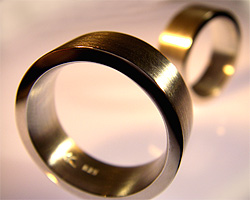
|
Affordability
... a note by Kerstin
"Because
of the high price of gold and platinum, the popular assumption
for an "affordable" wedding band is often silver.
But there are other exciting options. If your wedding
budget is a little restricted I can also discuss with
you lesser known recycled precious metal and crafting
choices.
There is also the far less recognized aesthetic regarding
what shade of precious metal may look best with your skin
tone. This, to me is one of the most important style facets
as I demonstrate that there is an extraordinary coalescence
between precious metal hues and skin colour. This is why
I also offer an exclusive selection of recycled precious
metals of various hues. Below, I invite you to carefully
consider mid-priced to high-end precious metal configurations
which might enable you to choose a balance between long
term durability, style and affordability."
Gold,
Silver, Palladium or Platinum Band Rings? Which Colour?
NOTE:
Kerstin Laibach only ever uses precious metals (always
recycled) of the absolute highest quality - and none contain
nickel.
LAIBACH'S
RECYCLED PRECIOUS METAL CRAFTING OPTIONS INCLUDE:
- Platinum (highest
grade with 95% platinum alloy)
- 24ct Gold (Fine
gold used for various techniques and detail - also 20ct
and 22ct)
- 18ct Yellow Gold
750/-
- White Gold (either
14ct or 18ct)
- Champagne Gold
18ct
- Hamilton Gold
14ct
- 18ct Rose Gold
750/-
- 18ct Red Gold
750/-
- 14ct Gold 585/-
(Lighter Yellow)
- Green Gold (14ct)
for special inlay and other detail work*
- Pd 950 Palladium
- Pd 500 Palladium
- Sterling Silver
- Fine silver (for
various techniques)
- Combinations of
precious metal options are also available
* As
with all Laibach precious metals, green gold is recycled
and not new-mined and thus ecologically the purest ethical
option. Laibach's green gold is gold with a green hue
and not to be confused with other jewellers promoting
fair trade gold (which is new-mined) as "Green gold".
A
Useful Description of Recycled Precious Metal Choices
Used by Kerstin Laibach
a) RECYCLED
STERLING SILVER:
It is important to understand that silver is a softer
metal than gold and is much more prone to wear, damage
and distortion when worn on a daily basis.
Kerstin Laibach crafts her silver rings with strength
in mind to help withstand wear and tear associated with
the softness of this precious metal. However, besides
tarnishing** quickly, having a wedding ring made entirely
in silver can in the long run prove to be a false economy
as you will most certainly require it to be reinforced,
remade or choose to replace with a gold, palladium or
platinum version.
Due to the high price of gold, you may opt for silver
instead. This is understandable, but in the long term
you may wish to consider the following option.
b) RECYCLED
PALLADIUM* (instead of silver):
Palladium is from the platinum group of metals but priced
roughly in the middle between silver and gold. It's main
advantage over silver is that it doesn't wear down and
tarnish** like silver. Palladium has a distiguished character,
conveying a "nobel" hue, much towards white
gold and platinum.
Although harder than silver, palladium is softer than
gold, and with heavy wear could suffer more from dents
and slight distortion than its gold counterpart. However,
because palladium is from the platinum group of metals
with similar metallurgical characteristics, it is less
likely to "wear down" so much as gold, (and
far less than silver) but instead the metal "shifts".
There are two palladium options. Palladium 950 contains
more pure palladium. Palladium 500 is slightly cheaper
and is alloyed with more silver and copper, and is darker
in colour (a similar hue to stainless steel) and is also
slightly softer than Palladium 950.
* When gold
prices are high and a piece made entirely of gold seems
a little too far to stretch, Palladium is often touted
as a more affordable and thus trendy option. I wish to
stress that, trends aside, it is more aesthetically relevant
to look at palladium as an enhancement of a design, just
like any other colour of precious metal. I should also
stress that, when applicable, the inclusion of palladium
in my designs can be attributed to its durability as a
long lasting asset to a jewellery piece.
c) A COMBINATION
OF RECYCLED SILVER OR PALLADIUM WITH RECYCLED GOLD:
If a restricted budget is an issue but you still prefer
the yellow hues of a gold on the upper surface, I mainly
recommend combining an external layer of gold on top of
a foundation / base design made of silver or palladium.
The gold also helps keep the ring rigid over years of
wear. This combination of metals in Laibach designs can
also look very appealing.
d) RECYCLED
YELLOW GOLD:
With options of 14, 18, 20 or 22 carat (depending on design)
these steps also make a diference on the strength and
durability of the ring. In yellow gold, the higher the
carat means a more vivid colour, and when it comes to
a balance of vibrancy and robustness, 18ct yellow gold
is traditionally the most appealing for a long-term wedding
band ... and it won't tarnish.
To give you a rough idea of its long-lasting characteristics,
18ct yellow gold is much more dense than silver and 50%
heavier. 22ct (or even 24ct) is only usually suggested
for rings as a design embelishment and in areas of the
ring not subjected to too much impact. This is because
higher carat gold is softer and can subsequently bend
and dent more easily.
I do not use 9ct gold. Do not be fooled by the superficial
appearance of a 9ct gold ring in a jewellery shop looking
as radiant and intense as an 18ct gold ring. It only means
it has been plated
with a thin layer of fine gold which will soon wear off.
(See
plating information).
9ct gold has
a very low gold content and so radiates much less colour.
The mainly non-precious alloy metals in a 9ct gold ring
means it tarnishes* and is less malleable in character.
There is also more risk of allergic
reactions
with low carat rings. (Please note that none of the precious
metals I use contain nickel alloying).
e) RECYCLED
WHITE GOLD:
I provide two white gold options: 14 ct and 18ct., which
is alloyed with palladium for best results. The slight
diference in colour is that 18ct white gold has a more
yellow hue, while 14ct is harder with a whiter hue. Depending
on the design, either of these options are equally as
appealing and I highly regarded either as a dependable
material for creating special rings.
f) RECYCLED
CHAMPAGNE GOLD:
I provide this subtle and beautifully stylish option in
18ct. Champagne gold is essentially a white gold but with
different alloy ratio, (which still includes palladium)
to give its unique, sophisticated tint.
g) RECYCLED
HAMILTON GOLD:
As with champagne gold, Hamilton gold is another lesser
known, delicately distinctive and stylish alternative
to rose or yellow. Hamilton gold is a 14ct alloy which
falls between the hues of 14ct red gold and 14ct yellow
gold. (see picture below)
h) RECYCLED
PLATINUM:
Platinum is the most dense of all precious metal options
(100% heavier than silver). When contacting
Laibach Atelier
please always ask for a comparison quote between white
gold options or platinum; depending on the current precious
metal prices, platinum prices can occasionally be closely
comparable with gold.
i) YOUR OWN
GOLD FROM BROKEN / UNWANTED FAMILY JEWELLERY:
Providing the yellow or rose gold in old jewellery is
of sufficient quality (hallmarked) for melting / alloying
and forging, this is the most environmentally friendly
path you can take when I create your jewellery piece.
It means no refining and thus no extra transporting to
refiners and processing. (Just as with gold recycling,
all new mined gold has to be refined and thus graded so
it can be properly hallmarked). Upon commissioning I will
advise you as to how your old jewellery might be suitable
for use ... for both ethical and sentimental consideration.
More about this further down the page.
Please also note that for ethical reasons I do not use
titanium or similar industrially alloyed chemical elements.
See explanation at the bottom of this page.
** TARNISHING
With some people, silver and very low carat golds (particularly
the inside of rings) can tarnish very quickly, while with
others it can remain relatively untarnished for longer
periods. It all depends on the skin chemistry of each
individual. In rare occassions this increase in tarnishing
may also become more apparent when you take medication.
If you do have low carat gold pieces with alloys containing
a higher copper mix, all you need to do is clean them
more regularly to maintain their original appearance.
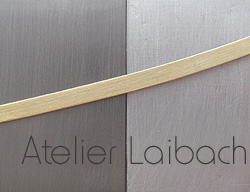 |
Left: Unpolished Palladium
500 on the left side and unpolished Sterling silver
on the right side with a strip of unpolished 18ct
gold laid on top. |
Exquisite
Recycled Gold Colour Choices
Kerstin Laibach
is happy to discuss a much wider colour palette to create
the perfect hue of recycled golds and other precious metals
for your wedding bands.
Here are just
some of the options:
IN 14ct RECYCLED
GOLD
- Light yellow gold
- Yellow gold
- Rose gold
- Red gold
- Hamilton Gold
- White gold
IN 18ct RECYCLED GOLD
- Deep yellow gold
- Yellow gold
- Rose gold
- Red gold
- Champagne gold
- White gold
As partners, you
may each wish to have the same Laibach ring design, but
in different colours. I can suggest stunning colour matching
combinations for band rings when shown together.
For example:
- Champagne Gold and Rose
Gold
- Platinum and Red Gold
- Dark Palladium and Deep
Yellow Gold
Recycled Precious Metal
Pallettes
(Please note, due to different hues in
computer / tablet screens these pallettes should only
be refered to as a rough guide)
| 14ct Gold |
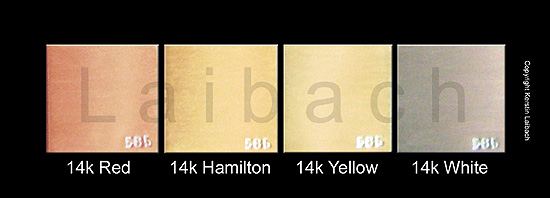 |
| 18ct Gold |
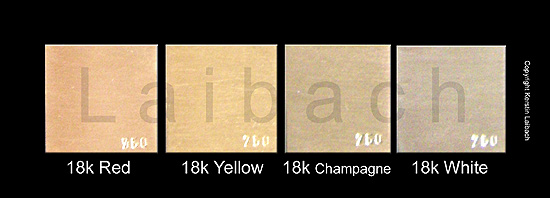 |
| Platinum and Palladium |
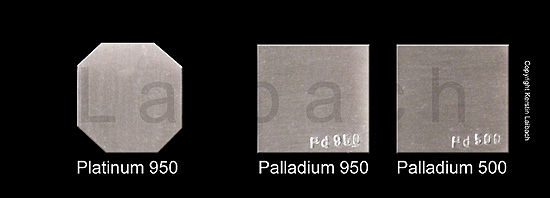 |
Please
get in touch
if you wish to further discuss these precious metal options
for your Laibach rings.
Using
Your Old Gold to Create Your New Rings. Kerstin explains
this ... the most environmentally friendly and sentimental
option.
"I
specialize in crafting wedding and partnership rings and
all other jewellery using your old family gold. This has
become the most popular option with many of my clients,
particularly with those visiting my atelier / gallery
in the Black Forest. Apart from being the most environmentally-tuned
method to create your rings, it also provides strong sentimental
continuity. First I will inspect your old jewellery. If
I see pieces which I firmly believe should not be melted
down I will advise you to keep them. If neccessary, I
can also restore or repair such fine pieces for you. If
your old family gold is of a type and condition which
would be suitable to melt into new rings for you, and
has otherwise no redeeming value except for its scrap
value, I will discuss the integration process with you
during consultation."
How
Thick Should my Rings Be?
When
you wear the same ring daily such as wedding or engagement,
it is under constant stress and the more busy your hands
are the faster your ring is subjected to wear and tear.
Therefore, the thickness and overall construction of a
ring is one of the most important aspects to ensure longevity
without it quickly suffering from bending, buckling and
even loss of precious stones.
Many factory-made and some "designer" rings
are often very thin underneath their aesthetic appearance.
Thin means far less precious metal used and therefore
a more attractive price to the customer. But such a flimsy
ring ultimately means that wear and tear become quickly
apparent - to an extent were it becomes shapeless, bent
and ultimately of little heirloom value.
The principle of structural stability is integral to all
high-end Laibach goldsmith designs - whether it be a plain
court ring or a highly sculptured piece. To ensure such
stability, a Laibach ring is always structurally balanced
on every dimensional aspect - width, thickness and stone
mounting supports. Importantly, all these aspects are
taken into consideration when making a ring; based on
your finger size, the width you require and how busy you
are with your hands during your everyday life - either
at work or play. These "engineering" factors
are what determines robustness and stability to your lifelong
investment while still retaining a balance between comfort
and design appeal.
Kerstin Laibach hand-forges her rings to last, hopefully
for generations and therefore the solid precious metal
thickness of her band rings average at 2mm thick and never
less than 1.5mm ... not a typical 0.8 to 1mm thickness
often found elsewhere.
Please consider this important factor when enquiring
for a cost estimate
. It may be helpful to scroll back up this page to refer
to KerstinLaibach's precious metal types and to consider
how silvers, golds and platinums behave differently under
wear and tear.
Two
Rings on the Same Finger and other Q and A's
Q. Is
there a downside to continuously wearing two rings on the
same finger?
A. In some
countries it is traditional to wear both an engagement
and wedding ring on the same finger. The consequences
of this is substantial wear and damage through continual
rubbing of the two rings. Some marriage and engagement
rings are designed to match and be worn together, but
in the long term even matched rings eventually means side
contact wear between the two
due to constant friction, resulting in a slow but expensive
loss and waste of precious metals, which at some point
will mean major repair work to the two bands.
Kerstin Laibach undertakes the restoration of wedding-engagement
sets and individual bands damaged through contact wear.
But from the outset she advises couples to steer away
from this common-style trend of contrived bridal sets
which often don't "lock"together sufficiently
to help minimize friction wear. Only
on request, Kerstin Laibach offers linked wedding / engagement
ring sets ... and these are uniquely precision made to
be substantially locked together, creating almost zero
friction wear. Please
get in touch
if you require this special design option.
Q. Why do you not use titanium?
A. The nature of
titanium, being an “extreme” industrially alloyed chemical
element, does not align with my principles and therefore I
don’t see any redeeming / positive environmental aspects
in specifically using the metal for vanity-wear such as
jewellery.
From my perspective, there are far too many
environmentally negative complexities throughout the
entire manufacturing process of titanium - including
alloying/recycling. The very high intensity of processing
involved throughout and the general poor formability of
titanium deem it unsuitable for true ethical and
handcrafting practices. Titanium jewellery is not a
hand-made product in the true sense of goldsmith forging
and rolling, but instead machined using bars, tubes or
sheeting – or pre-manufactured shapes. In most cases,
titanium-based construction creates large amounts of
pre-consumer waste (swarf etc.)
As a result, I do not
use this metal and do not consider it an environmental
choice for my jewellery creation – whether recycled or
not.
In stark contrast to titanium, any environmental
footprint is very, very much lighter when working with
recycled classic precious metals - and above all, I can
completely reform reclaimed classic metals to create new
pieces indefinitely and with absolute minimal cost to the
environment - something that you can’t do with a metal
such as titanium – which lacks almost any malleable
characteristics.
Titanium jewellery sellers often tout
it’s hypolallergenic properties. However, I should point
my clients to a Laibach page which discusses the pros,
cons and myths about jewellery allergies.
www.kerstinlaibach.com/ethicalweddingrings/allergies.htm
I should also point out that rings made of titanium cannot
easily be resized - something which most ring wearers will
require, possibly many times, over the years. The amount
by which a titanium ring can be resized is so minimal to
be essentially irrelevant in comparison to what the wearer
may actually require. However, on rare occasions I do have
clients who bring in titanium rings for resizing.
Depending on the size and shape, I can sometimes offer
creative solutions to an otherwise inflexible problem.
More detailed Q and A's regarding Kerstin Laibach's
ethical and vegan approach based on her principles
can be found here.
|